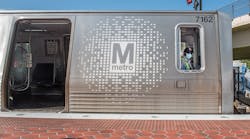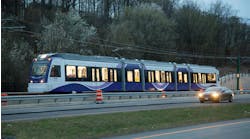WMATA looking at a three-year, $55-million fix for its 7000 series wheels
The National Transportation Safety Board (NTSB) opened the public docket for its ongoing investigation into the 2021 derailment of a Washington Metropolitan Area Transit Authority (WMATA) train in Arlington, Va. The derailment saw the authority’s entire fleet of 7000 series railcars temporarily pulled from operation and served as the starting point of a nearly 16-month endeavor to fully restore these railcars to service.
NTSB has not determined a probable cause of the derailment, but WMATA says the more than 1,400 pages of factual information does provide a roadmap to return the 7000 series cars to full service. In short, the authority will repress the wheels of its 7000 series fleet in a process that is preliminarily estimated to take 36 months and $55 million to complete.
“We appreciate the NTSB making the technical reports available, so we can develop our plan to begin repressing wheels on these trains at a higher standard, including the fit onto the axles,” said WMATA Chief Operations Officer Brian Dwyer. “We are preparing the technical documents and training plan while we collaboratively advance the next version of our return to service plan for approval by the Washington Metrorail Safety Commission (WMSC).”
Among the NTSB investigation materials are independent reports from three entities – Hatch LTK, Kawasaki Rail Car and MxV Rail – that performed work with the aim of determining a root cause for the 2021 derailment.
Two of the three reports found evidence of microslip in the derailment. In extremely simple terms, the axle of a wheel assembly is threaded through a wheel’s hub using an interference fit, where force is needed to assemble the components. Wheel set assemblies experience various loads and stresses during regular operations. If the fit between hub and shaft is inadequate, the shaft can eventually slip within or out of the hub.
The Hatch LTK report found the most comparable vehicle and wheel set in service at a peer agency had an interface fit that was higher than that of WMATA’s 7000 series wheel set assemblies. WMATA says its internal and external engineering experts agree an increase to the fit and press tonnage used to mount rail wheels onto axles is required for the 7000 series.
“The process of changing all 5,984 wheels on 2,992 axles for 748 railcars may take a couple of years to complete,” Dwyer said. “We thank our customers for their patience and want them to know the good news is we will be able to fix about 20 cars a month to safely build up more trains and restore the safe, frequent and reliable service the region needs.”
WMATA has been progressing through a phased return to service for the 7000 series railcars, with the most recent advancement occurring on Jan. 28, where the authority is measuring wheels every seven days. WMATA says this practice will remain while it revises its Return to Service plan that will require approval from the WMSC. The authority also noted it would continue its inspections of wheels with measurements for every 7000-series rail car until its wheels are reassembled at the new, higher standard.
“Process changes must be safe and deliberate,” said WMATA Chief of Safety and Readiness Theresa Impastato. “We will take the time needed to get this right because every single rail car must undergo a rigorous process to be ready to serve our customers and support our employees.”
NTSB’s public docket is available on the NTSB website.

Mischa Wanek-Libman | Group Editorial Director
Mischa Wanek-Libman is director of communications with Transdev North America. She has more than 20 years of experience working in the transportation industry covering construction projects, engineering challenges, transit and rail operations and best practices.
Wanek-Libman has held top editorial positions at freight rail and public transportation business-to-business publications including as editor-in-chief and editorial director of Mass Transit from 2018-2024. She has been recognized for editorial excellence through her individual work, as well as for collaborative content.
She is an active member of the American Public Transportation Association's Marketing and Communications Committee and served 14 years as a Board Observer on the National Railroad Construction and Maintenance Association (NRC) Board of Directors.
She is a graduate of Drake University in Des Moines, Iowa, where she earned a Bachelor of Arts degree in Journalism and Mass Communication.







